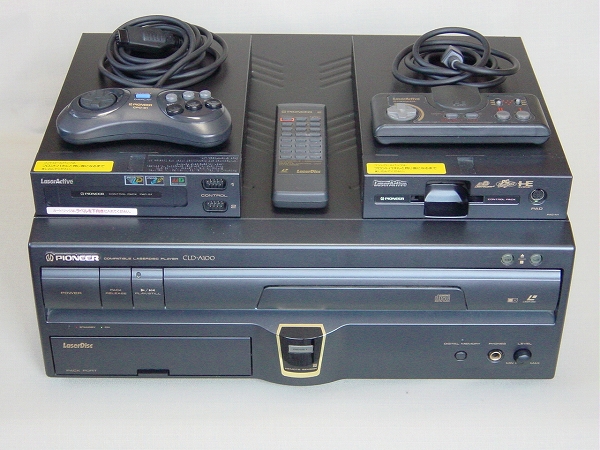Laseractive, from here. Equipped with both PAC modules.
Background/History:
The LaserActive was a laserdisc based system, like the RDI Halcyon, but far more successful. Released on August 20, 1993 in Japan and September 13, 1993 in the US, the LaserActive was unique in that it required two components to work as a video game console. The base component was a laserdisc player, the Pioneer CLD-A100, and the second component was the PAC module. By itself, the base component could play standard laserdisc movies and CD-ROMs. There were two available PAC modules, each able to play their own library of laserdisc games. The PAC modules were not region locked, and could play games released anywhere in the world. Both PACs could be attached at once.
The Sega PAC, released by Pioneer and Sega, had a library of laserdisc games (called Mega LD) and could also play the full library of Sega Genesis/Mega Drive and Sega CD titles. Around 40 Mega LD discs were released. The NEC PAC, released by Pioneer and NEC, has a separate library of laserdisc games (called LD-ROM2), as well as being able to play TurboGrafx-16 and TurboGrafx-CD games. (The TurboGrafx-16 games were region locked). Around 15 LD-ROM2 games were released.
The game genres covered a wide range.
There was also a karaoke module available, as well as 3D glasses.
What Makes It Obscure?
Quite simply, price and value. The LaserActive was state-of-the-art; however, high technology is not cheap. The base unit cost $970, and each PAC was $600 extra. A LaserActive with the Sega PAC would set you back $1,570, before games. Adjusted for inflation, this is $2,550. While this sum got you a hefty library of thousands of games to choose from, keep in mind that a new Genesis and Sega CD could be bought for around $350 at the time ($569 today) and could play all US-released games other than the Mega LDs. In effect, this was a $1,220 premium ($1,981 today) to be able to play 40 Mega-LD games and imported games.
The LaserActive with the NEC module was also $1,570, but its game library was far smaller. The TurboGrafx line was much less successful and saw much fewer game releases than the Sega Genesis and CD did. The TurboDuo, a unit integrating the function of a TurboGrafx-16 and TurboGrafx-CD, could be bought for around $300 at the time ($487 today), and even offered an adapter to play games from different regions for both. In effect, this was a $1,270 premium ($2,063 today) to be able to play 15 Mega-LD games and have an inability to play foreign TurboGrafx-16 games.
If one used the LaserActive as a standalone Laserdisc player and CD player, the value proposition was better, but even a good laserdisc player, CD player, and game console were still far less expensive than a LaserActive. However, the value was not so bad as to prevent the system's release, and unlike the Halcyon, the LaserActive with Sega PAC did offer a large game library with the high price. The Halcyon came into a dead video game market. The LaserActive arrived into a lively video game market.
About 10,000 LaserActives were sold. Today a LaserActive and Sega PAC can still be bought for under $1,000.

No comments:
Post a Comment